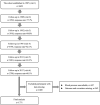Associations of Long-Term Visit-to-Visit Blood Pressure Variability With Subclinical Kidney Damage and Albuminuria in Adulthood: a 30-Year Prospective Cohort Study
- PMID: 35360932
- PMCID: PMC9093226
- DOI: 10.1161/HYPERTENSIONAHA.121.18658
Associations of Long-Term Visit-to-Visit Blood Pressure Variability With Subclinical Kidney Damage and Albuminuria in Adulthood: a 30-Year Prospective Cohort Study
Abstract
Background: Recent evidence indicates that long-term visit-to-visit blood pressure variability (BPV) may be associated with risk of cardiovascular disease. We, therefore, aimed to determine the potential associations of long-term BPV from childhood to middle age with subclinical kidney damage (SKD) and albuminuria in adulthood.
Methods: Using data from the ongoing cohort of Hanzhong Adolescent Hypertension study, which recruited children and adolescents aged 6 to 18 years at baseline, we assessed BPV by SD and average real variability (ARV) for 30 years (6 visits). Presence of SKD was defined as estimated glomerular filtration rate between 30 and 60 mL/min per 1.73 m2 or elevated urinary albumin-to creatinine ratio at least 30 mg/g. Albuminuria was defined as urinary albumin-to creatinine ratio ≥30 mg/g.
Results: During 30 years of follow-up, of the 1771 participants, 204 SKD events occurred. After adjustment for demographic, clinical characteristics, and mean BP during 30 years, higher SDSBP , ARVSBP , SDDBP , ARVDBP , SDMAP , ARVMAP , and ARVPP were significantly associated with higher risk of SKD. When we used cumulative exposure to BP from childhood to adulthood instead of mean BP as adjustment factors, results were similar. In addition, greater long-term BPV was also associated with the risk of albuminuria. Long-term BPV from childhood to middle age was associated with higher risk of SKD and albuminuria in adulthood, independent of mean BP or cumulative exposure to BP during follow-up.
Conclusions: Identifying long-term BPV from early age may assist in predicting kidney disease and cardiovascular disease in later life.
Keywords: albuminuria; blood pressure; cardiovascular diseases; cohort studies; kidney.
Figures


Similar articles
-
Short-Term but not Long-Term Blood Pressure Variability Is a Predictor of Adverse Cardiovascular Outcomes in Young Untreated Hypertensives.Am J Hypertens. 2020 Nov 3;33(11):1030-1037. doi: 10.1093/ajh/hpaa121. Am J Hypertens. 2020. PMID: 32710778
-
Association of Blood Pressure Trajectories in Early Life with Subclinical Renal Damage in Middle Age.J Am Soc Nephrol. 2018 Dec;29(12):2835-2846. doi: 10.1681/ASN.2018030263. Epub 2018 Nov 12. J Am Soc Nephrol. 2018. PMID: 30420422 Free PMC article.
-
Short-term Blood Pressure Variability and Incident CKD in Patients With Hypertension: Findings From the Cardiovascular and Metabolic Disease Etiology Research Center-High Risk (CMERC-HI) Study.Am J Kidney Dis. 2023 Apr;81(4):384-393.e1. doi: 10.1053/j.ajkd.2022.08.017. Epub 2022 Oct 12. Am J Kidney Dis. 2023. PMID: 36241008
-
Subclinical Kidney Damage in Hypertensive Patients: A Renal Window Opened on the Cardiovascular System. Focus on Microalbuminuria.Adv Exp Med Biol. 2017;956:279-306. doi: 10.1007/5584_2016_85. Adv Exp Med Biol. 2017. PMID: 27873229 Review.
-
Clinical relevance of visit-to-visit blood pressure variability: impact on renal outcomes.J Hum Hypertens. 2014 Jul;28(7):403-9. doi: 10.1038/jhh.2013.96. Epub 2013 Oct 17. J Hum Hypertens. 2014. PMID: 24132140 Review.
Cited by
-
Long-Term Time in Target Range for Systolic Blood Pressure Since Childhood and Midlife Arterial Stiffness.JACC Asia. 2025 Jan 7;5(1):101-112. doi: 10.1016/j.jacasi.2024.10.021. eCollection 2025 Jan. JACC Asia. 2025. PMID: 39886204 Free PMC article.
-
The association of long-term trajectories of BMI, its variability, and metabolic syndrome: a 30-year prospective cohort study.EClinicalMedicine. 2024 Feb 12;69:102486. doi: 10.1016/j.eclinm.2024.102486. eCollection 2024 Mar. EClinicalMedicine. 2024. PMID: 38370536 Free PMC article.
-
Blood Pressure Variability in Clinical Practice: Past, Present and the Future.J Am Heart Assoc. 2023 May 2;12(9):e029297. doi: 10.1161/JAHA.122.029297. Epub 2023 Apr 29. J Am Heart Assoc. 2023. PMID: 37119077 Free PMC article. Review.
-
Determinants and Clinical Impact of Visit-to-visit Blood Pressure Variability in Patients with Heart Failure with Preserved Ejection Fraction.JMA J. 2025 Jul 15;8(3):871-881. doi: 10.31662/jmaj.2024-0256. Epub 2025 Jun 27. JMA J. 2025. PMID: 40786446 Free PMC article.
-
Update on Hypertension Research in 2021.Hypertens Res. 2022 Aug;45(8):1276-1297. doi: 10.1038/s41440-022-00967-4. Epub 2022 Jul 5. Hypertens Res. 2022. PMID: 35790879 Free PMC article. Review.
References
-
- Weiner DE, Tighiouart H, Amin MG, Stark PC, MacLeod B, Griffith JL, Salem DN, Levey AS, Sarnak MJ. Chronic kidney disease as a risk factor for cardiovascular disease and all-cause mortality: a pooled analysis of community-based studies. J Am Soc Nephrol. 2004;15:1307–1315. doi: 10.1097/01.asn.0000123691.46138.e2 - PubMed
-
- Eckardt KU, Coresh J, Devuyst O, Johnson RJ, Köttgen A, Levey AS, Levin A. Evolving importance of kidney disease: from subspecialty to global health burden. Lancet. 2013;382:158–169. doi: 10.1016/S0140-6736(13)60439-0 - PubMed
-
- Schieppati A, Remuzzi G. Chronic renal diseases as a public health problem: epidemiology, social, and economic implications. Kidney Int Suppl. 2005;(98):S7–S10. doi: 10.1111/j.1523-1755.2005.09801.x - PubMed
-
- Yuyun MF, Khaw KT, Luben R, Welch A, Bingham S, Day NE, Wareham NJ; European Prospective Investigation into Cancer in Norfolk (EPIC-Norfolk) population study. Microalbuminuria independently predicts all-cause and cardiovascular mortality in a British population: The European Prospective Investigation into Cancer in Norfolk (EPIC-Norfolk) population study. Int J Epidemiol. 2004;33:189–198. doi: 10.1093/ije/dyh008 - PubMed
-
- Vlek AL, van der Graaf Y, Spiering W, Algra A, Visseren FL; SMART study group. Cardiovascular events and all-cause mortality by albuminuria and decreased glomerular filtration rate in patients with vascular disease. J Intern Med. 2008;264:351–360. doi: 10.1111/j.1365-2796.2008.01970.x - PubMed
MeSH terms
Substances
Grants and funding
LinkOut - more resources
Full Text Sources
Medical
Miscellaneous

